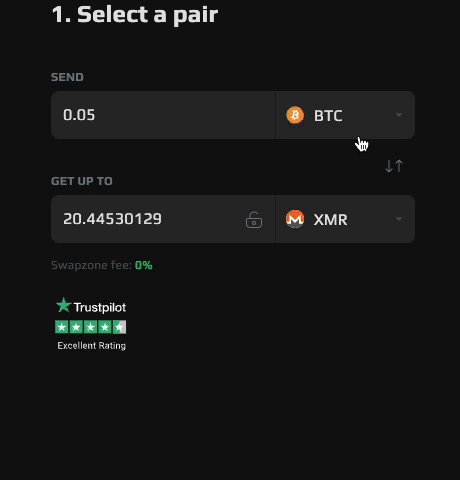Swapzone fee: 0%
Exchange Monero Easily on Swapzone
Looking to exchange XMR? Swapzone offers a streamlined platform to compare rates, choose the best offer, and trade XMR with ease. Whether you're new to crypto or a seasoned trader, our service ensures a smooth and secure transaction process. Start swapping today and take advantage of top-tier rates.


Swapzone is a non-custodial instant crypto exchange aggregator that helps users scan the network of registered exchanges globally and gives them a comprehensive list of those that support a particular trading or swap pair.
Our platform ensures crypto trading stays uninterrupted and gives users more flexibility and choice. With 18+ registered crypto exchanges and 1000+ supported cryptocurrencies, Swapzone users can make more informed buying decisions using a string of parameters, such as price, ratings, transaction speed, and so much more.
It's fair to say that Swapzone instant crypto exchange aggregator brings the best crypto trading deals in one place, allowing you to make the most of your swaps and conversions.

Compare and swap for the best terms with Swapzone
Swapzone fee: 0%





Compare the value of the desired amount of BTC in XMR using the Swapzone Bitcoin to Monero converter and swap BTC to XMR at the best price.

Please be aware that some of the listed services may perform AML/KYC procedures to prevent criminal activity. Remember that it is the user's responsibility to conduct due diligence prior to proceeding with an exchange deal. Swapzone cannot be held liable for any crypto exchange losses, delays, computer malfunctions, or any other damages associated with any action taken, regardless of the user's interpretation of the information provided on cryptocurrency exchange services or crypto exchange offers.
Frequently asked questions
Instant Crypto Exchange Aggregator
Swapzone is a non-custodial instant crypto exchange aggregator that helps users scan the network of registered exchanges globally and gives them a comprehensive list of those that support a particular trading or swap pair.
Our platform ensures crypto trading stays uninterrupted and gives users more flexibility and choice. With 18+ registered crypto exchanges and 1000+ supported cryptocurrencies, Swapzone users can make more informed buying decisions using a string of parameters, such as price, ratings, transaction speed, and so much more.
It's fair to say that Swapzone instant crypto exchange aggregator brings the best crypto trading deals in one place, allowing you to make the most of your swaps and conversions.
Swapzone's Crypto API
Swapzone's API is a set of programming codes that allows any platform to benefit from the rich services of our aggregator. Installing it on your crypto platform affords you the following perks:
- Your users can swap crypto at the best market rates, curated from some of the best exchanges in the world without leaving your website. That translates to better trust in your platform and more users consequently.
- Every significant price variation among different exchanges for a supported crypto pair is an opportunity for your users to buy at a cheap rate and even sell higher.
- Users will save up to 20% in exchange fees for every transaction conducted through the API.
- Your platform gets a 0.05% - 0.25% share of every profit Swapzone makes from each transaction.
The principle behind the API is to facilitate data transmission between Swapzone and any platform using it. You can install the API in simple steps—signup for a personal partner account to get started. Swapzone provides sufficient documentation to integrate the API key into your platform easily.
How Swapzone Works
Swapzone is actively monitoring and comparing some of the best crypto exchange rates for all the available crypto pairs. We get these real-time rates directly from the various crypto exchanges we partner with, present them to you, and allow you to make your swaps on your preferred exchange.
It's time-consuming for you to visit each of these exchanges one after the other to compare rates or even create user accounts with them. Our instant crypto exchange service saves you the hassles and affords you the optimum satisfaction and benefits.
Once you select the digital currencies you want to swap, you will receive offers from various exchanges with their rates. You can make a pick based on the available parameters on the offers.
How We Compare Rates
Swapzone has several parameters or filters for comparing rates and getting the best deals. Here are the top factors to consider when choosing an exchange on our platform:
- Types of Rates: A transaction takes minutes to process. During this period, crypto prices may fluctuate significantly. As such, we offer two types of rates to enable users to make the most of such situations:
- Fixed-rate means that irrespective of the price fluctuations, you will get your swapped token at approximately the rate you saw when you hit the 'exchange' button.
- Floating rates allow you to profit from price volatility. During the waiting period, if the price changes to your favor, you will get more coins or tokens than the figure you saw when you hit the exchange button.
However, if the prices fluctuate against you, you will receive less. Floating rates are risky; if you're unwilling to take the risk, opt for the fixed rate.
- ETA: ETA or 'estimated time of arrival' gives an approximate amount of time a crypto exchange would typically take to complete a transaction. Choose an exchange with the lowest ETA if a fast transaction is your highest priority.
- Reviews: we encourage users of our instant crypto exchange service to give reviews after using an exchange. While the number of reviews does not expressly reflect how often people use a particular crypto exchange, it tells how many users were willing to share their experiences after using it. The reviews are worth reading.
- Exchanger's Ratings: Apart from text reviews, users can rate exchanges from 1 - 5 stars. Exchanges with the highest ratings offered the best experience to our users.
- Fees: Swapzone does not charge fees for transactions. However, we've incorporated the crypto exchange and network fees into each rate you see. Crypto exchanges with low fees often offer the best deals.
- Best Rate Tag: After curating a list of exchanges that supports your swap pairs, we designate the 'best rate' on the one with the most favorable rate. You may opt for the exchange if you prioritize rates over other parameters.
- Recommended Tag: Based on all the parameters above, we suggest our recommended picks for each crypto pair you choose. Bear in mind that the recommended pick for a particular crypto pair today may not be the same tomorrow.
How To Swap Cryptocurrency
As an instant crypto exchange aggregator, you don't need to create an account on Swapzone to use our services. Once you've decided on the cryptos you want the swap; you can start and complete the process within a timeframe of 5 minutes minimum. For instance, if you want to swap Bitcoin (BTC) for Litecoin (LTC), follow these simple steps:
- Select the BTC to LTC pair and fill in the total amount of BTC you wish to exchange
- Compare the rates on offer to select the best BTC to LTC exchange deal and click the exchange button on the right to continue.
- Fill in the receiving wallet for LTC.
- Copy your generated Bitcoin address and send your BTC deposit.
- Swapzone will take some time to process the transaction and notify you of its successful completion.
- Remember to spare some seconds to leave a review on your crypto exchange providers or rate us!
We are here to help you with any issue at every stage of the transaction. Feel free to contact us!

We check all exchangers for the risk of freezing funds. Your funds will definitely reach you!
We're showing the offers from the most popular and reliable exchange providers. Pick the best offer for your crypto pair!
It's really hard not to find the crypto you need on Swapzone :)




